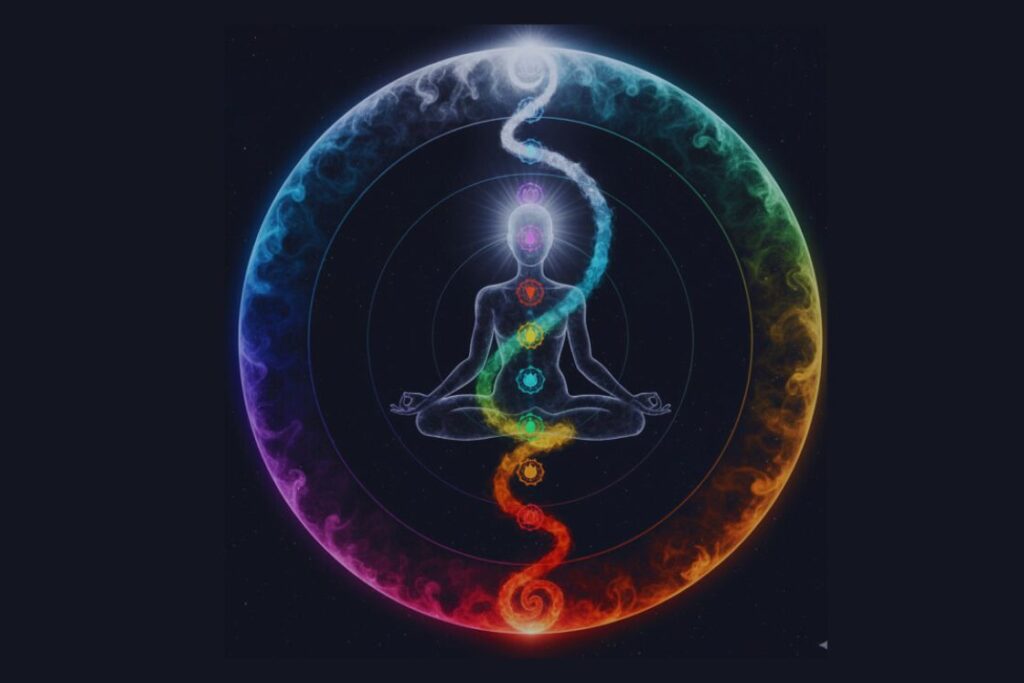
Many yoga teachers know Kundalini as an energy practice, but few explore its roots in Tantra- the philosophy that connects creation with consciousness.
Tantra and Kundalini Yoga are two ancient paths that explain how consciousness and energy work together in life. Tantra offers understanding, while Kundalini Yoga provides the direct experience of that truth.
In Tantric philosophy, life is seen as the play of two inseparable forces; Shiva, the still awareness, and Shakti, the creative power. From their union arises everything in existence, from subtle thought to solid matter.
When Shakti unfolds from the stillness of Shiva, she creates layers of reality known as tattvas – moving from pure consciousness to the physical world. This movement is called the descent of energy, where the unseen becomes visible as matter.
Kundalini Yoga describes the same journey in reverse0 the return of energy from matter to spirit. The divine power that created the universe lies dormant at the base of the spine as Kundalini Shakti. When awakened and guided upward through the chakras, it dissolves inner limitations and awakens higher awareness.
Together, Tantra and Kundalini Yoga reveal the full circle of existence, from unity to diversity, and back to unity again.
Tantra and the concept of creation
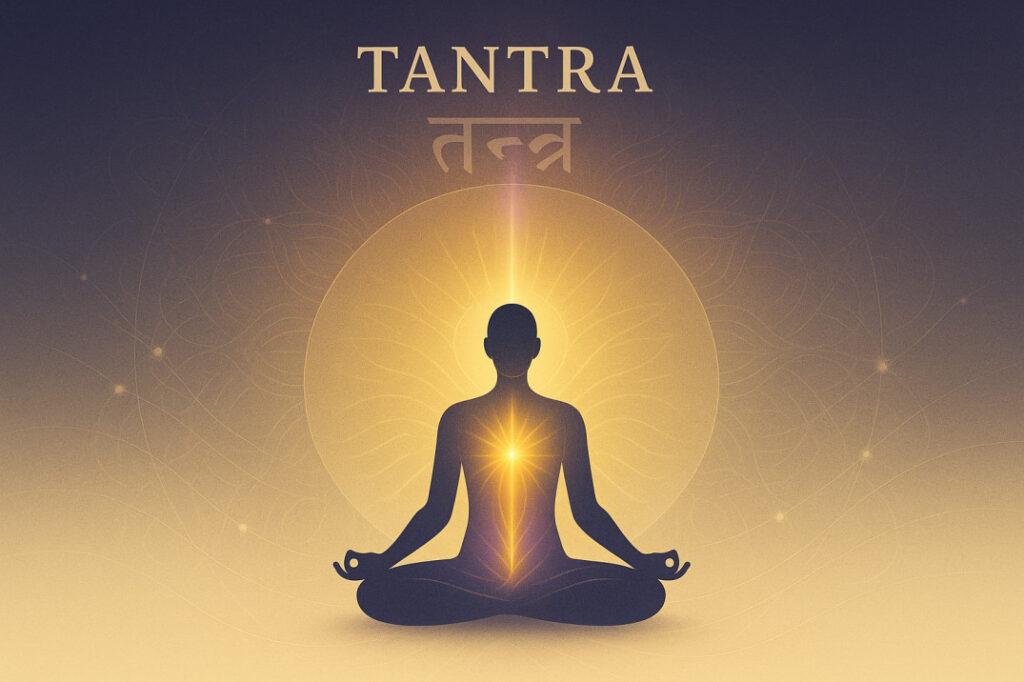
In Tantra, creation is not a one-time event but a continuous unfolding of consciousness into energy. At its core are Shiva and Shakti the still and the dynamic aspects of one reality. When Shakti stirs within Shiva’s stillness, creation begins to take form.
From this first movement arise thirty-six tattvas, or principles of existence. They show how pure awareness transforms step by step into the physical world. The final stage of this descent is Prithvi Tattva, the earth element where spirit becomes matter.
This process is known as the descent of energy. Yet even as energy takes form, it never loses its divine essence. The same consciousness that created the cosmos also lives within each person. Recognising this truth is the foundation of all Tantric practice.
Also Read: Concept of Creation in Tantra
The reverse journey: involution and spiritual evolution
Kundalini Yoga teaches the reverse of creation- a process called involution, or the return of energy to its source. This inward movement is not about escape but about rediscovering the divine within.
In yoga, this is known as Bhūta Shuddhi, the purification of the five elements: earth (Prithvi), water (Apas), fire (Agni), air (Vayu), and space (Akasha).
Through breath, meditation, and awareness, these elements are harmonised and absorbed back into one another from the dense to the subtle- until only consciousness remains.
This inner purification is the true meaning of spiritual evolution. As energy rises, the senses withdraw inward, the mind becomes still, and awareness expands. The yogi experiences the same energy that once descended as creation now moving upward as liberation.
Also Read: Bhuta Shuddhi – Yogic Process to Purification of Five Elements
Understanding kundalini: meaning and symbolism
The word Kundalini comes from kundal, meaning coil. It refers to the coiled spiritual energy resting at the base of the spine, in the Root Chakra. This energy is Shakti in her potential form the dormant power of creation within the human being.
Even while dormant, Kundalini sustains life by releasing a gentle flow of prāṇa, the life force. When awakened, she rises through the Sushumna Nadi, the central channel, activating each chakra and transforming awareness at every level.
Kundalini is revered as the Divine Mother, the creative power of Shiva. Her awakening is not just an energetic experience but a spiritual rebirth the return of energy to its source, the meeting of Shakti and Shiva within.
Also Read: Nadis and Chakras: Working Mechanism of Subtle Body
The symbol of the coiled serpent
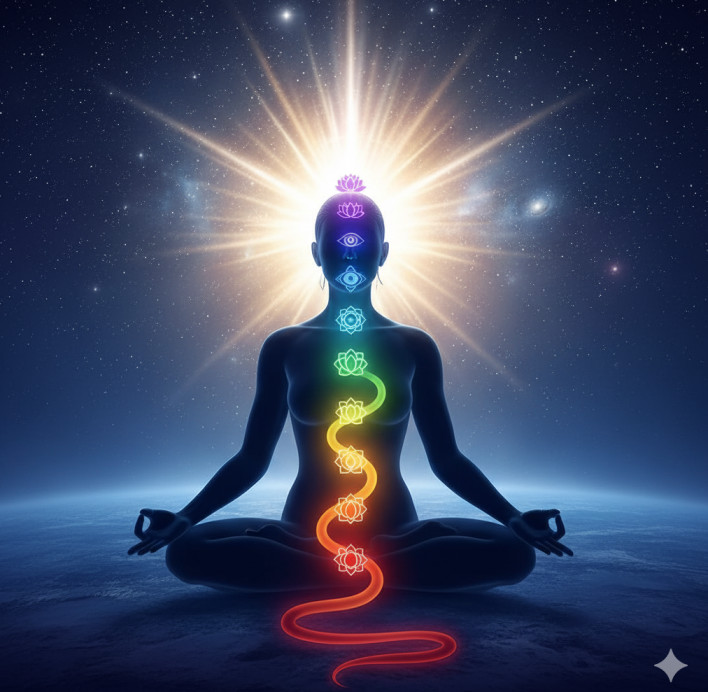
Kundalini is often shown as a serpent coiled three and a half times at the base of the spine. This is a symbol of potential energy, resting yet ready to awaken.
The three coils represent the three gunas, or qualities of nature:
- Sattva — balance, clarity, and peace
- Rajas — activity, passion, and movement
- Tamas — inertia, heaviness, and ignorance
The half coil represents the spark of consciousness beyond these three the awareness that leads to freedom.
This imagery also reflects the three states of consciousness– waking, dreaming, and deep sleep — with the half coil symbolising the fourth state, Turīya, or pure awareness.
When Kundalini awakens, she lifts us beyond the limits of the mind into this fourth state the still light of self-awareness. The serpent thus symbolises transformation, wisdom, and the rise of inner power.
Also Read: The Symbolism and Power of the Serpent in Kundalini Yoga
The flow of energy: ida, pingala, and sushumna
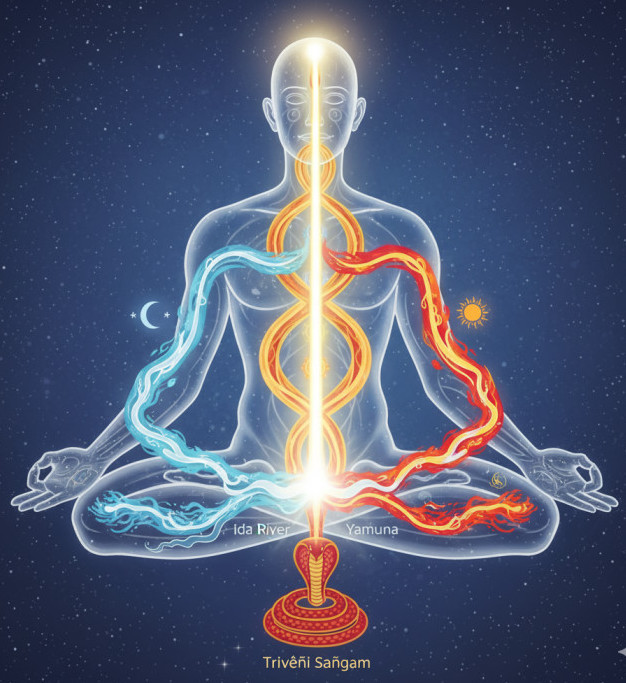
According to yogic philosophy, the awakening of Kundalini depends on the balance of energy moving through three subtle channels in the body, called nāḍīs. These nāḍīs are the invisible pathways through which prāṇa the life force flows and sustains both body and mind.
Just as rivers carry water across the earth, the nāḍīs carry energy through the inner landscape of consciousness. Among the thousands of energy channels, three are said to be most important: Ida, Pingala, and Sushumna. Together, they create the foundation for pranic balance and spiritual awakening.
Ida Nadi – The Lunar Channel
Ida Nadi runs along the left side of the spine. It is connected with the moon’s cooling and calming energy and governs the mental and emotional nature of our being. When Ida is active, it encourages introspection, stillness, and sensitivity.
In yogic symbolism, Ida is linked with the Ganga River, representing purity, intuition, and flow. A person dominated by Ida energy tends to be gentle, reflective, and inward-focused.
Pingala Nadi – The Solar Channel
Pingala Nadi flows along the right side of the spine. It carries the sun’s warming and activating energy, supporting vitality, strength, and outward expression. When Pingala is dominant, the mind becomes alert, the body feels energised, and action arises naturally.
Pingala is symbolically connected to the Yamuna River, representing movement, dynamism, and the creative fire of life.
Sushumna Nadi – The Central Channel
Sushumna Nadi flows through the centre of the spine, connecting the Mūlādhāra Chakra at the base with the Sahasrara Chakra at the crown of the head. This channel represents spiritual awareness and serves as the pathway for Kundalini Shakti to ascend.
When Ida and Pingala are unbalanced, Sushumna remains dormant. But once these two currents flow in harmony, prāṇa naturally enters Sushumna, allowing the inner energy to rise. This balanced state is the true essence of Haṭha Yoga — “Ha” meaning the sun and “Tha” meaning the moon. Haṭha Yoga aims to unite these two forces so the central channel can awaken.
In yogic symbolism, the meeting point of the three nāḍīs Ida, Pingala, and Sushumna is called Triveṇī Saṅgam, the sacred confluence of the rivers Ganga, Yamuna, and Saraswati. Just as these rivers merge in harmony, the balance of pranic currents within us awakens a deeper spiritual flow.
When prāṇa begins to move freely through Sushumna, the breath becomes quiet, the mind turns inward, and meditation deepens naturally. This is the first movement of Kundalini Shakti — the moment when inner energy begins its upward journey, leading towards awakening and expanded consciousness.
The union of sun and moon: the meaning of hatha Yoga
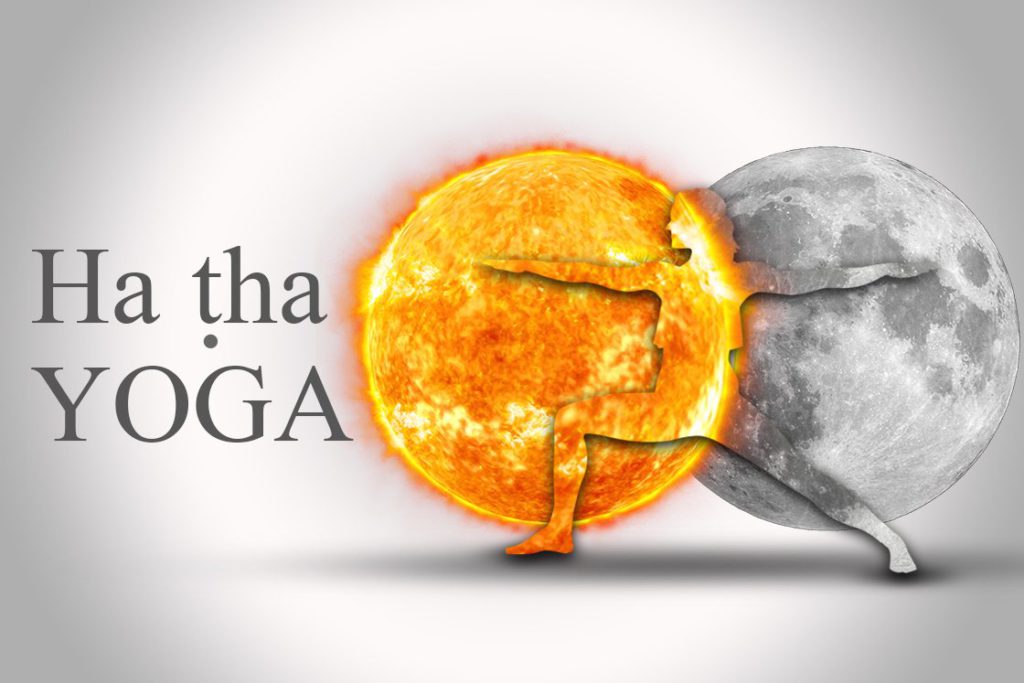
The word Haṭha Yoga comes from two Sanskrit sounds Ha, meaning sun, and Tha, meaning moon. These two forces represent the dual energies that shape both the universe and the human body.
The sun symbolises Pingala Nadi, the channel of warmth, vitality, and action. The moon symbolises Ida Nadi, the channel of coolness, calmness, and reflection. These two currents are constantly flowing within us, shaping the rhythm of body and mind one creating movement and activity, the other bringing rest and renewal.
In daily life, one of these energies often dominates. When the solar current is too strong, we become restless, driven, and tense. When the lunar current is too strong, we feel dull, tired, or withdrawn. The aim of Hatha Yoga is to bring balance between the two, creating harmony in both the nervous system and consciousness.
Through the regular practice of asana (posture), pranayama (breath control), mudra (gesture), and bandha (energy lock), the Ida and Pingala channels are purified. As balance develops, energy begins to flow freely through the Sushumna Nadi, the central channel that leads to higher awareness.
Join Our Live 40-Day Kundalini Yoga Training Program
This is the true purpose of Hatha Yoga not only to build strength or flexibility, but to prepare the body and mind for spiritual awakening. When the sun and moon energies unite, the inner current opens, and Kundalini Shakti begins to rise naturally.
Hatha Yoga is therefore the foundation of Kundalini Yoga. It steadies the body, regulates the breath, and quiets the mind. Once these three are aligned, the dormant energy within awakens without force or effort.
The union of sun and moon is not just a symbolic idea- it is a living experience. It brings balance to every aspect of life: activity and rest, thought and silence, outer action and inner stillness. When this inner harmony is achieved, the breath flows evenly, the mind becomes peaceful, and awareness turns inward.
This balanced state marks the first light of transformation the beginning of the awakening of Kundalini.
Kundalini yoga: the path of transformation
Kundalini Yoga is often seen as the next step after Hatha Yoga. While Hatha Yoga balances the body and mind by cleansing the energy pathways, Kundalini Yoga works directly with the inner life force- the dormant power of Shakti that rests at the base of the spine.
The purpose of this practice is to awaken Kundalini and guide her gently upward through the chakras, the subtle energy centres along the spine. Each chakra reflects a different level of awareness and expression of energy. As the Kundalini moves through them, the limitations tied to each level dissolve, allowing higher states of consciousness to unfold.
When energy awakens at a chakra, the natural qualities of that centre such as creativity, willpower, compassion, or clarity begin to shine more freely. This process is often described as the flowering of consciousness. Just as lotuses bloom one above another, each chakra opens in its own time, revealing the hidden potential within.
The ascent of Kundalini is a gradual and natural process that unfolds through consistent practice, self-awareness, and purity of life. It is supported by traditional yogic tools, including:
- Asana – prepares and strengthens the body.
- Pranayama – regulates the breath and awakens prana (life energy).
- Bandha and Mudra – direct energy inward and upward.
- Mantra and Meditation – focus the mind and refine vibration.
As Kundalini rises, it purifies the nāḍīs (energy channels), cleanses the mind, and awakens spiritual awareness. The practitioner begins to feel a deep inner clarity and connection with life. Individual consciousness expands naturally toward the universal.
In its essence, Kundalini Yoga is the science of transformation. It refines the lower energies of instinct and desire into higher energies of wisdom and awareness. The sleeping potential becomes awakened power, and ordinary experience transforms into a path of realisation.
When Kundalini finally reaches the Sahasrara Chakra at the crown of the head, she unites with Shiva, the still consciousness. This union marks the fulfilment of the yogic journey the merging of energy and awareness, matter and spirit. It is the state of oneness, known in Tantra as liberation (moksha) or Sat-Chit-Ananda- Being, Consciousness, and Bliss.
Join Our Live Tantra Based Kundalini Yoga Course
Key texts and classical sources
The roots of Kundalini Yoga and Tantra lie in the ancient Sanskrit scriptures that describe both the philosophy and the practical science of awakening. Among these, two texts are considered the primary sources:
- Ṣaṭ-Chakra-Nirūpaṇa (Description of the Six Chakras)
- Pādukā-Pañchaka (Five Verses on the Footstool of the Guru)
These classical works map the subtle body, explaining the chakras, nāḍīs, and the rise of Kundalini Shakti through each level of awareness until her union with Shiva at the crown of the head. They detail the flow of prāṇa, the signs of awakening, and the transformation that unfolds as consciousness expands beyond the limits of the mind.
For modern readers, these ancient teachings were translated and illuminated by Sir John Woodroffe, writing under the name Arthur Avalon, in his renowned work The Serpent Power. This book brings together the original Sanskrit verses and Woodroffe’s detailed commentary, creating a bridge between traditional Tantric wisdom and modern understanding of energy and consciousness.
While The Serpent Power offers deep philosophical insight, a more accessible and practice-based guide can be found in Kundalini Tantra by Swami Satyananda Saraswati. Written in clear, simple language, this book presents the same principles in a way that is easy to apply. It explains the relationship between the chakras, breath, and mind, and provides safe, systematic methods for awakening energy through yoga and meditation.
Together, these two texts represent the two essential aspects of the Kundalini tradition:
- The Serpent Power reveals the scriptural foundation and philosophical depth,
- Kundalini Tantra offers the practical guidance for everyday yogic life.
Both remind us that Kundalini Yoga is not a modern invention, but an ancient science of consciousness that continues to guide sincere seekers toward balance, awareness, and spiritual awakening. By studying these texts, practitioners gain not only the method of awakening energy but also the wisdom to approach it with reverence, patience, and purity of intention. learn not only how to awaken energy, but also why it must be approached with purity, patience, and reverence.
Kundalini as the goddess and goal of yoga
In the yogic and Tantric traditions, Kundalini is honoured as the Divine Mother, the living Shakti within every being. She represents the creative power of the universe- the force through which consciousness takes form as life. Resting silently at the base of the spine, she holds the blueprint of both creation and awakening.
Kundalini is often described as the counterpart of Shiva, who symbolises pure consciousness. Shiva is stillness, the unchanging witness; Shakti is movement, the power of creation. Together, they form the two aspects of a single reality. When they are seen as separate, life appears divided — between inner and outer, spirit and matter, self and world. When they unite, this sense of division dissolves, revealing the natural state of wholeness.
The purpose of Kundalini Yoga is to restore this inner union. When the dormant Shakti awakens, she begins her ascent through the Sushumna Nadi, rising through the chakras and purifying each level of awareness. When she reaches the Sahasrara Chakra at the crown of the head, she merges again with Shiva, symbolising the realisation that energy and consciousness were never truly apart.
This union marks the fulfilment of yoga- the state of Samadhi, where awareness becomes one with the source. In this experience, the yogi realises the essence of Sat-Chit-Ananda:
- Sat – pure existence,
- Chit – pure consciousness,
- Ananda – pure bliss.
Here, the body and mind remain active, but they no longer create separation. Every breath and movement becomes an expression of the same divine rhythm. The world is no longer seen as something outside of us, but as the dance of Shiva and Shakti- consciousness in motion.
Thus, Kundalini is both the Goddess and the goal of yoga the journey and its destination. When Shakti unites with Shiva within, the yogi realises that the seeker, the path, and the divine are one and the same. This is the essence of Tantra to recognise that all of creation is sacred, and awakening lies not in escape, but in the awareness of unity that already exists.
Conclusion
The teachings of Tantra and Kundalini Yoga describe one continuous journey the movement of divine energy from its source into creation, and its return to pure awareness. Tantra helps us understand how this energy manifests, while Kundalini Yoga shows how it can rise again through practice and inner discipline.
This journey begins at the base of the spine, where Kundalini Shakti rests in silence. Through yoga, breath, and meditation, this energy awakens and ascends through the chakras, clearing blocks and opening deeper understanding.
The awakening of Kundalini is not a physical event but an inner transformation. When the energy reaches the Sahasrara Chakra, it unites with Shiva, symbolising the complete union of energy and awareness.
The message of Tantra is timeless: what we seek outside is already within. Through steady practice, patience, and awareness, Kundalini Yoga helps us return to that truth the state of balance, clarity, and joy that is our natural essence.

